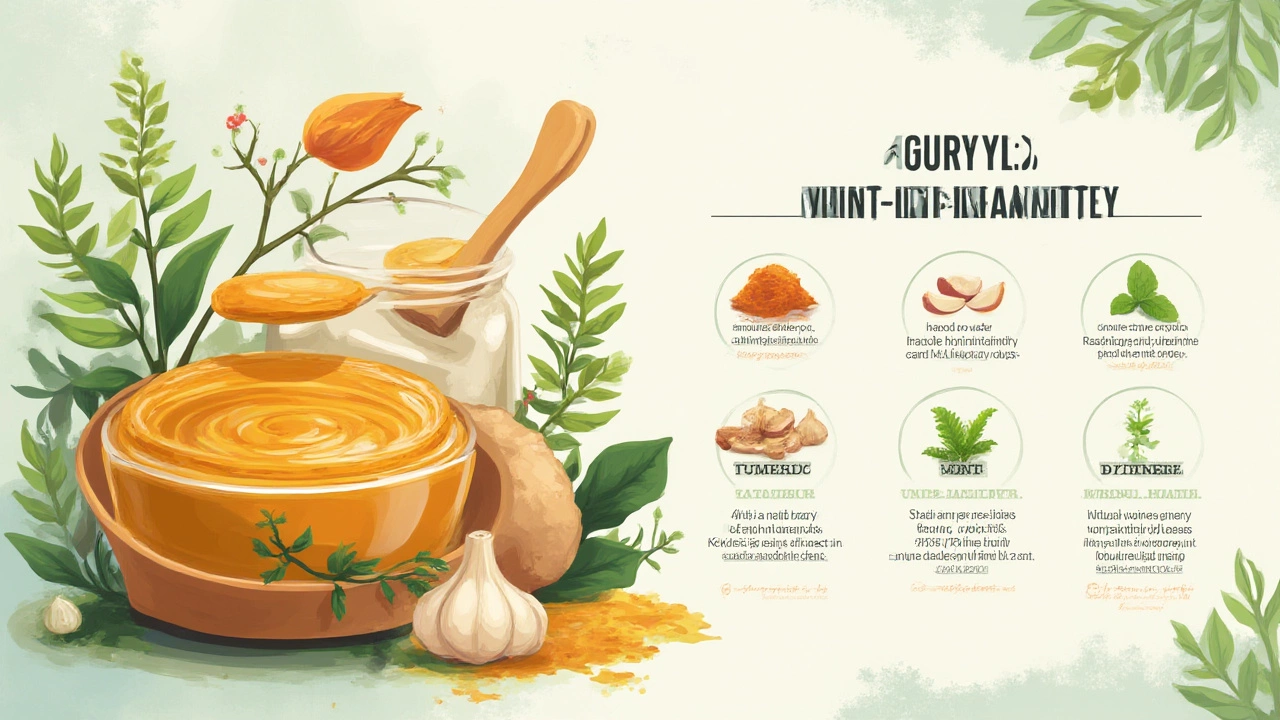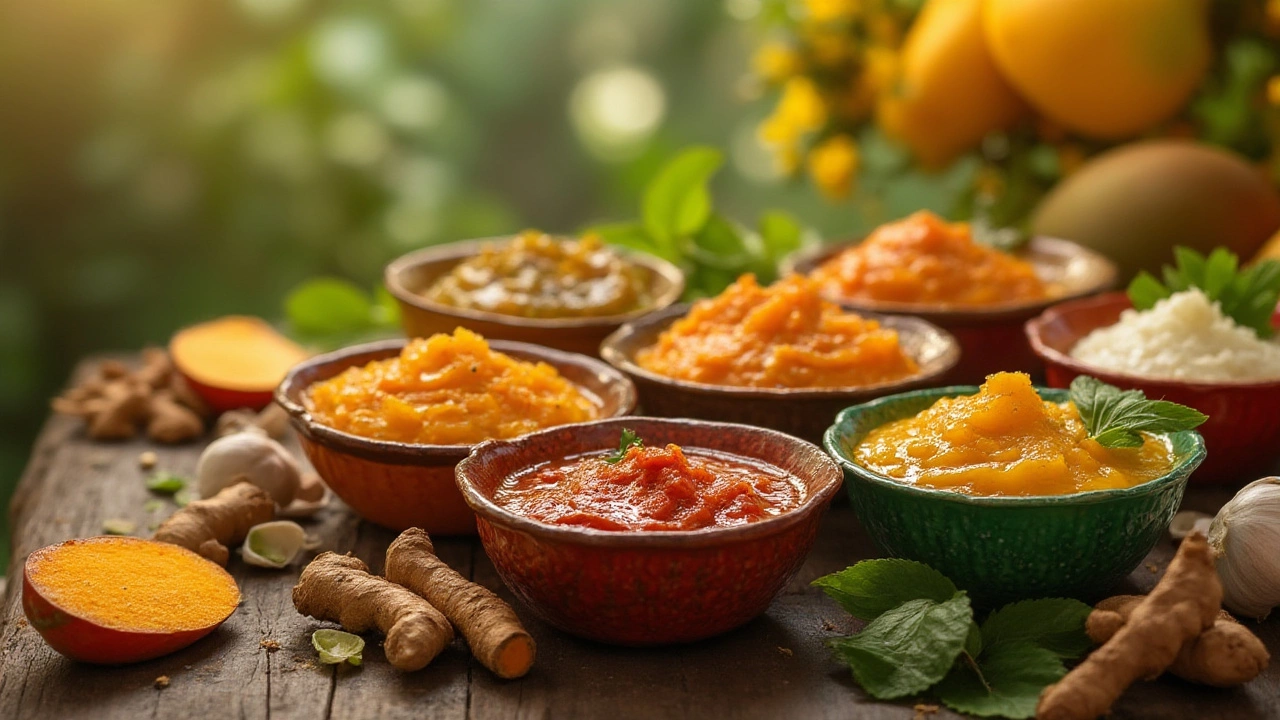That rush of bright, spicy, tangy flavor you get with a spoonful of chutney isn’t just a punch for your taste buds—it might come with some serious wellness perks too. Indian homes and kitchens are never far from a jar of chutney, and for good reason. It’s not just tradition or taste; some of the basic ingredients in classic chutney recipes have real, science-backed anti-inflammatory properties. But what’s the truth behind the claims? Does something so delicious really help fight inflammation, or is it just another food fad dressed up in masala?
What’s Really Inside Chutney?
Let’s get nosy about what’s in your chutney. This isn’t some one-size-fits-all sauce. Instead, “chutney” covers a whole lineup of fresh, blended, or cooked relishes, usually made from all sorts of fruits, vegetables, spices, and herbs. From the zippy coriander chutney on a Mumbai sandwich to the classic British mango chutney, recipes can get wild and creative.
But here are the backbones you’ll spot again and again: coriander (cilantro), mint, curry leaves, ginger, garlic, tamarind, lime, coconut, chilies, onions, and sometimes fruits like mango. Most of these aren’t just picked for the zing—they pack their own nutritional superpowers. Coriander and mint both deliver loads of antioxidants, B vitamins, and vitamin C. Fresh ginger and garlic are famous in health circles for fighting inflammation and supporting immune function. Turmeric? If you come across chutneys with a yellow gleam, chances are it’s from turmeric, which is celebrated in every health magazine and grandma’s kitchen alike for its active compound curcumin—a powerful anti-inflammatory.
Let’s look at a simple breakdown of nutrients often found in a tablespoon (15g) serving of classic green chutney, based on average homemade recipes:
| Ingredient | Trial Anti-Inflammatory Compound | Potential Benefit |
|---|---|---|
| Coriander/Cilantro | Quercetin | Antioxidant, fights cellular damage |
| Mint | Rosmarinic acid | Reduces allergy-related inflammation |
| Ginger | Gingerol | Reduces pain and swelling |
| Garlic | Allicin | Lowers inflammatory markers in blood |
| Turmeric | Curcumin | Blocks inflammatory signals |
| Chilies | Capsaicin | Reduces pain signals; may combat chronic inflammation |
| Lime | Vitamin C | Helps repair tissue damage |
What’s interesting: most of these ingredients have been studied not only for their flavor but for their powerful anti-inflammatory effects. Real lab work has shown coriander may lower levels of C-reactive protein, a marker for inflammation in the body. Turmeric extract has even shown results in patients with joint issues, and ginger, believe it or not, has been compared with ibuprofen for its pain-fighting abilities.
Chutney and Chronic Inflammation: Is There a Link?
Let’s get something straight: chutney by itself isn’t a magic pill. The real question is, do the key ingredients in this zesty condiment actually help with the kind of inflammation that matters—the slow, ongoing type linked to chronic illness?
Chronic inflammation works in sneaky ways. It’s the kind of ‘silent’ trouble that’s tied to diabetes, arthritis, heart disease, and heck, even tiredness most days. So, finding natural ways to keep it in check gets a lot of attention. Multiple studies suggest that diets rich in leafy herbs, spices, and vegetables—things that fill most handmade chutneys—help nudge down those inflammatory markers mentioned earlier. Ginger and turmeric stand out: if you toss a thumb of ginger and a dash of turmeric into your blend, you’re feeding your body compounds studied for turning off pain and swelling pathways in your cells.
There’s a real advantage in the way chutney is made, too. Crushing, pounding, or blending these ingredients—as opposed to just heating them up or letting them sit—can help your body access more of these anti-inflammatory goodies. And when you eat chutney, not only are you getting a pop of antioxidants and nutrients, you’re usually eating it cold or fresh, so nothing’s cooked down and wasted.
Want another tip? Pair chutney with foods that have their own kick of anti-inflammatory powers like carrot sticks, roasted sweet potatoes, or baked chicken. It’s all about layering those benefits.

How Different Types of Chutney Stack Up
If you wander into an Indian grocery or scroll through a recipe blog (guilty as charged), you’ll find chutneys in a dizzying variety of colors and flavors. But not all chutneys deliver the same health benefits, especially if you’re hoping to add more anti-inflammatory bombs to your plate.
Herb-based chutneys, like coriander, mint, or curry leaf, usually shine brightest in the anti-inflammatory department. Fruit-based chutneys—hello, mango and pineapple—are loaded with vitamins but might come with high sugar, depending on how they’re made. (Some bottled versions are packed with more sugar than soda. Check those labels!) Coconut chutney is another favorite, especially in South Indian breakfasts. Coconuts have their own benefits: healthy fats and a nice dose of fiber. But when coconut is paired with chilies, curry leaves, and ginger, you get, once again, the team of inflammation-fighting heroes.
Tamarind is another staple you’ll spot in darker chutneys and sauces. Its tartness hides a rich supply of antioxidants and polyphenols, studied for lowering blood sugar and easing some inflammation. But, tamarind chutney can contain a lot of jaggery or sugar—great on taste but a flag for anyone watching blood sugar or calories.
A common pro tip: make chutney fresh at home and skip preservatives, weird additives, or sugary fillers. Homemade means you can crank up the ginger, garlic, and greens for an extra anti-inflammatory boost.
Easy Ways to Maximize Chutney’s Benefits
Want to unlock the best effects from your chutney habit? For a start, stick with simple, raw, and homemade versions. Pack them full of fresh coriander, mint, ginger, garlic, and if you handle the spice, green chilies. Some like to sneak in a pinch of turmeric powder—just mix it well since the flavor can get intense if you go overboard.
- Use olive oil (just a few drops) instead of ghee for binding or added richness, if the recipe calls for it.
- Squeeze lime or lemon in instead of vinegar; it preserves vitamin C and adds more antioxidants.
- Say no to sugar except a sprinkle if you must—your taste buds will adapt, promise!
- Serve chutney beside grilled veggies, roasted meat, or even as a punchy topping for salads. It gives a flavorful twist without lousy additives found in supermarket dressings.
- Freeze portions in ice-cube trays—this way you’ll never have to reach for bottled, sugar-loaded sauces in a rush.
Here’s a weird little fact: black pepper boosts curcumin absorption from turmeric like crazy—some studies suggest by up to 2000%. If your chutney has turmeric, try blending in a few black peppercorns, especially if fighting inflammation is your main goal.

Does Chutney Really Belong in Your Healthy Diet?
Maybe you’re skeptical—after all, can something this tasty really be good for you? Well, if you look at the Mediterranean Diet or Asian food habits, people who regularly eat herb-packed condiments like chutney, salsa, zhug, or green sauces have lower rates of chronic disease and inflammation. Most Indian families eat some form of fresh chutney daily. It’s not the only reason the Indian diet gets praised for its variety of spices and vegetables, but it’s one more sign that small, regular doses of these plant powerhouses can make a big difference over time.
But remember, not all chutneys are created equal. Watch out for store-bought brands with mystery ingredients—or chutneys with lots of added salt and sugar. Even the best homemade chutney is a supplement to your diet, not a replacement for eating a diverse mix of veggies, whole grains, and proteins.
If you want to test chutney’s anti-inflammatory promise, don’t just slap a big blob on your plate once a month. Make it a regular thing: a tablespoon alongside breakfast, lunch, or as a dip for snacks. Try new variations—kasundi for its mustardy punch, nut-based chutneys for healthy fats, or a simple coconut-mint blend that hits both flavor and wellness out of the park. Your body (and your taste buds) will thank you.
At the end of the day, the humble chutney is way more than a flavor sidekick. Treat it as a nutrition-packed upgrade for your meals—a burst of goodness in every spicy, tangy bite. And if you’re looking for an easy, fun way to sneak more anti-inflammatory foods into your routine, look no further than your home blender and a handful of herbs. Just remember, moderation works best, and there’s always room to tweak your recipe until it’s perfect for you.
